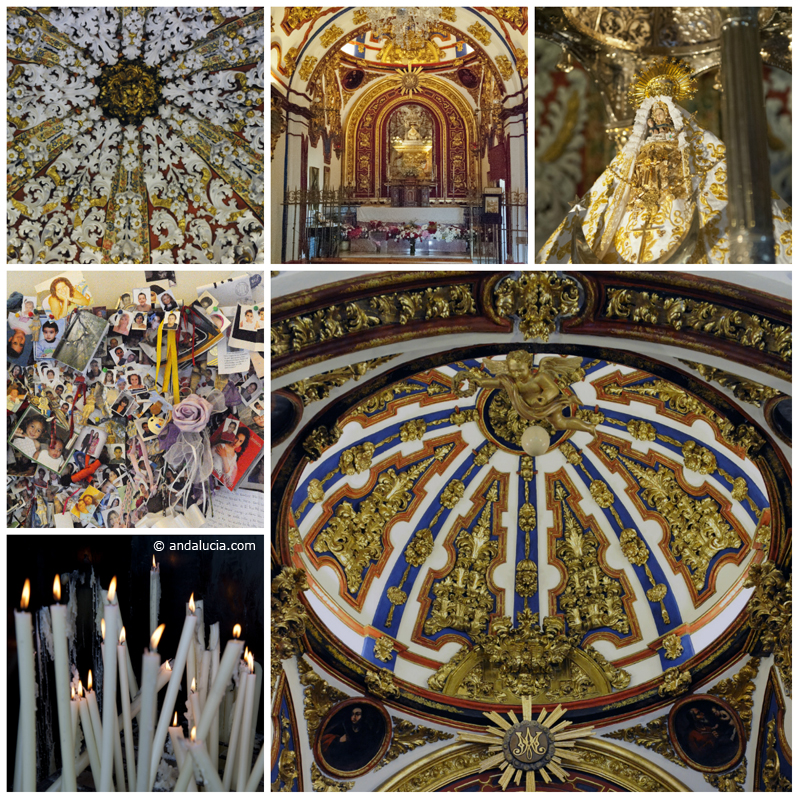
The Hermitage Chruch Nuestra Señora de los Remedios ( click to emlarge photos) © Michelle Chaplow |
|
Cartama - Ermita de Nuestra Señora de los Remedios
Ermita de Nuestra Señora de los Remedios - the town's patron saint - is still a focus of reverent pilgrimage for devout locals, and is perched high above Cártama's twisting streets. The shrine is well worth the visit and can be reached by climbing the vertiginous zig-zag path from the main square near the Pilar Alto Fountain. If it is a hot day, take some water along for the climb.
Hidden from view most of the way, the hermitage is a welcome sight on arrival, after the steep walk, as is the spectacular vista of the Guadalhorce Valley. In front of the fence that marks the entrance to the sanctuary's terrace, there are two stone benches where you can sit down and take in the view. One bears the inscription 'Viva la Santisima Virgin de los Remedios' with the date 1933. The other has the name of Jose Hidalgo Espildora, the Malageño industrialist who (presumably) donated both seats for pilgrims to rest after their climb, before entering the sanctuary itself.
Inside, you can see the 18th-century origins of the sanctuary in the unexpectedly ornate rococo ceiling, the crystal chandelier, and the elaborate gold mouldings and decorations. By contrast, the wooden benches for the congregation are simple to the point of austerity. It was built in the 17th century, over the original 15th-century building. The exterior of the sanctuary was restored in 2001, and the interior in 2007.
A statue of the revered Virgin is the centrepiece of the altar, protected behind a glass screen. It is a poignant place: by the doors are two noticeboards onto which the devout have pinned images and mementoes, photos old and faded, ribbons, scribbled names and notes, as well as - these days - ultrasound baby scans, of their loved ones, for whom they seek the Virgin's blessing and protection.
At the right-hand side of the altar is the entrance to a small vestry, which is incongruously plain and domestic compared to the flamboyance of the shrine. It contains some simple wooden furniture and a number of interesting historical photographs of the processions.
The statue of the Virgin can be reached via wooden stairs from the vestry. You will notice that the work, which is believed to be almost 600 years old, is much smaller than expected. It was said to have been discovered by a shepherd boy under a stone.
Every year on 22 April, the traditional Bajada de la Virgen takes place, during which the statue of Our Lady of Los Remedios is carried down from the sanctuary to the Parroquia de San Pedro in the town below. She remains there for several weeks, allowing townspeople and pilgrims to pay homage. The return procession back up to the hermitage takes place on the first Sunday in June — in 2025, this fell on 1 June. These dates (22–23 April for the descent and 1 June for the return) are confirmed annually and remain a deeply rooted tradition in Cártama’s religious calendar.
During the Civil War of 1936-39, the statue was taken from the shrine by the local priest and poet José Gonzalez Martin (1889 - 1956) to protect it from destruction at the hands of anti-clerical Republicans, who unknowingly destroyed the replica. The original was taken to South America and used to raise funds for Franco's cause, only returning to its home on the mountainside once the war had been won.
Tall votive candles, which can be purchased from the caretaker in the vestry, are burned in the large steel barbecue-like unit outside the hermitage.
The Ermita de Nuestra Señora de los Remedios was declared a Site of Cultural Interest (Bien de Interés Cultural - a designation that recognizes and protects properties of cultural significance in Spain) by the Junta de Andalucía in 2004. Architectural features remain intact and include the richly decorated baroque camarín (chapel behind the altar), ornamental plasterwork, and the overall structural design of the interior.
The sanctuary is open to visitors throughout the year, with seasonal opening hours. From November to March (Winter), it is open from 10:00 am to 1:00 pm, and again from 4:00 pm to 7:00 pm. From April to October (Summer), the hours are from 10:00 am to 1:00 pm, and then from 5:00 pm to 8:00 pm. Please note that the hermitage is closed on Wednesdays.